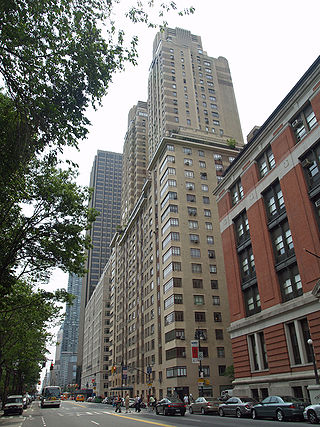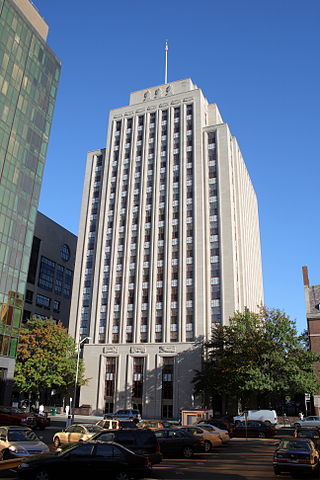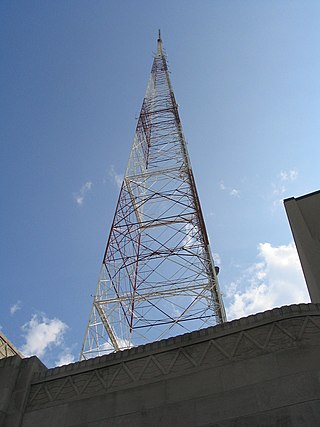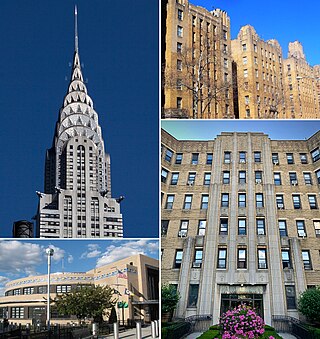
The Fan is a district of Richmond, Virginia, so named because of the "fan" shape of the array of streets that extend west from Belvidere Street, on the eastern edge of Monroe Park, westward to Arthur Ashe Boulevard. However, the streets rapidly resemble a grid after they go through what is now Virginia Commonwealth University. The Fan is one of the easterly points of the city's West End section, and is bordered to the north by Broad Street and to the south by VA 195, although the Fan District Association considers the southern border to be the properties abutting the south side of Main Street. The western side is sometimes called the Upper Fan and the eastern side the Lower Fan, though confusingly the Uptown district is located near VCU in the Lower Fan. Many cafes and locally owned restaurants are located here, as well as historic Monument Avenue, a boulevard formerly featuring statuary of the Civil War's Confederate president and generals. The only current statue is a more modern one of tennis icon Arthur Ashe. Development of the Fan district was strongly influenced by the City Beautiful movement of the late 19th century.

Oregon Hill is a historic working-class neighborhood in Richmond, Virginia. Oregon Hill overlooks the James River and Belle Isle, and provides access to Hollywood Cemetery. Due to the neighborhood's proximity to the Monroe Park Campus of Virginia Commonwealth University, the neighborhood is sometimes referred to as a student quarter because of its high college student population.
The Greater Richmond, Virginia area has many neighborhoods and districts.

Downtown Richmond is the central business district of Richmond, Virginia, United States. It is generally defined as being bound by Belvidere Street to the west, I-95 to the north and east, and the James River to the south. The Fan district borders it to the west, Highland Park to the north, Church Hill to the east, and Manchester to the south.

The Wells Fargo Building, originally the Fidelity-Philadelphia Trust Company Building, is a skyscraper in Center City, Philadelphia, Pennsylvania, United States. Designed in the Beaux-Arts style by the architectural firm Simon & Simon, the building was erected for the Fidelity-Philadelphia Trust Co. in 1928. The 30-story high-rise is listed on the National Register of Historic Places.

Built from 1938-40, the Art Deco style Model Tobacco Building is the primary six-story building of a six building collection of buildings comprising a former tobacco factory. Located at 1100 Jefferson Davis Highway, in Richmond, Virginia, the building was designed by the Chicago architecture firm of Schmidt, Garden and Erikson and is known for the 9' tall Moderne MODEL TOBACCO letters which dominate the north end of the building.

The El Dorado is a cooperative apartment building at 300 Central Park West, between 90th and 91st Streets adjacent to Central Park, on the Upper West Side of Manhattan in New York City. It was constructed from 1929 to 1931 and was designed by architect of record Margon & Holder and consulting architect Emery Roth in the Art Deco style. The El Dorado is 30 stories tall, with twin towers rising from a 19-story base. The building is a contributing property to the Central Park West Historic District, a National Register of Historic Places–listed district, and is a New York City designated landmark.

The Century is an apartment building at 25 Central Park West, between 62nd and 63rd Streets, adjacent to Central Park on the Upper West Side of Manhattan in New York City. It was constructed from 1930 to 1931 at a cost of $6.5 million and designed by the firm of Irwin S. Chanin in the Art Deco style. The Century is 30 stories tall, with twin towers rising from a 19-story base. The building is a contributing property to the Central Park West Historic District, a National Register of Historic Places–listed district, and is a New York City designated landmark.

One South Broad, also known as the Lincoln-Liberty Building or PNB Building, is a 28-story 472-foot (144 m) office tower in Center City, Philadelphia, Pennsylvania, United States. The art deco tower, designed by architect John Torrey Windrim as an annex for Wanamaker's department store, was completed in 1932. Wanamaker's Men's Store opened in the first seven floors of the building, which is located a block from Wanamaker's main store, and was intended to rival European department stores with its size and selection. In 1952, the Philadelphia National Bank (PNB) bought the building and converted it into offices and banking space. Until 2014, the building's bell tower was decorated on all four sides with PNB's initials in stainless steel 16 feet (4.9 m) tall. Wells Fargo is the main tenant, occupying almost half the building. The former banking space at street level was converted to retail and restaurant space in 2000.

Union Hill is a historic district of Richmond, Virginia. According to the Richmond Times Dispatch, the neighborhood "generally is bordered on the south by East Marshall Street and Jefferson Avenue, on the west by Mosby Street, on the north by O and Carrington streets, and angled on the east by North 25th Street." The neighborhood is on the Virginia Landmarks Register and the National Register of Historic Places, and is also one of sixteen designated "Old and Historic Districts" in Richmond.

The Allied Arts Building is a historic high-rise building located at 725 Church Street in Lynchburg, Virginia. It is currently being remodeled for apartments.

The Jefferson–Chalmers Historic Business District is a neighborhood located on East Jefferson Avenue between Eastlawn Street and Alter Road in Detroit, Michigan. The district is the only continuously intact commercial district remaining along East Jefferson Avenue, and was listed on the National Register of Historic Places in 2004.

The Eli, formerly the Southern New England Telephone Company Administration Building, is a skyscraper at 227 Church Street in downtown New Haven, Connecticut. Completed in 1938, it is the city's finest example of Art Deco architecture, and was headquarters to the Southern New England Telephone Company (SNET), which oversaw the building of the state's telephone networks. Designed by Douglas Orr and Roy W. Foote, it was added to the National Register of Historic Places in 1997.

The Four Corners Historic District is the intersection of Broad and Market Streets in Newark, New Jersey. It is the site of the city's earliest settlement and the heart of Downtown Newark that at one time was considered the busiest intersection in the United States. The area that radiates twenty-two square blocks from the crossroads is a state and federal historic district.

Weequahic is a neighborhood in the city of Newark in Essex County, in the U.S. state of New Jersey. Part of the South Ward, it is separated from Clinton Hill by Hawthorne Avenue on the north, and bordered by the township of Irvington on the west, Newark Liberty International Airport and Dayton on the east, and Hillside Township and the city of Elizabeth on the south. There are many well maintained homes and streets. Part of the Weequahic neighborhood has been designated a historic district; major streets are Lyons Avenue, Bergen Street, and Chancellor Avenue. Newark Beth Israel Medical Center is a major long-time institution in the neighborhood.

The Chestnut Hill–Plateau Historic District is a historic area in the Highland Park neighborhood of Richmond, Virginia. It is also known as 'Highland Park Southern Tip' on city neighborhood maps.

The Scott's Addition Historic District is a national historic district located in Richmond, Virginia.

Art Deco architecture flourished in New York City during the 1920s and 1930s. The style broke with many traditional architectural conventions and was characterized by verticality, ornamentation, and building materials such as plastics, metals, and terra cotta. Art Deco is found in government edifices, commercial projects, and residential buildings in all five boroughs. The architecture of the period was influenced by worldwide decorative arts trends, the rise of mechanization, and New York City's 1916 Zoning Resolution, which favored the setback feature in many buildings.

The Noonan Plaza Apartments are an eight-story Art Deco apartment complex in the Highbridge neighborhood of the Bronx in New York City. Built in 1931 by Horace Ginsbern & Associates, with exteriors by Marvin Fine, the building forms part of the rich tapestry of Art Deco apartments in the West Bronx. It was made a New York City designated landmark in 2010.




















